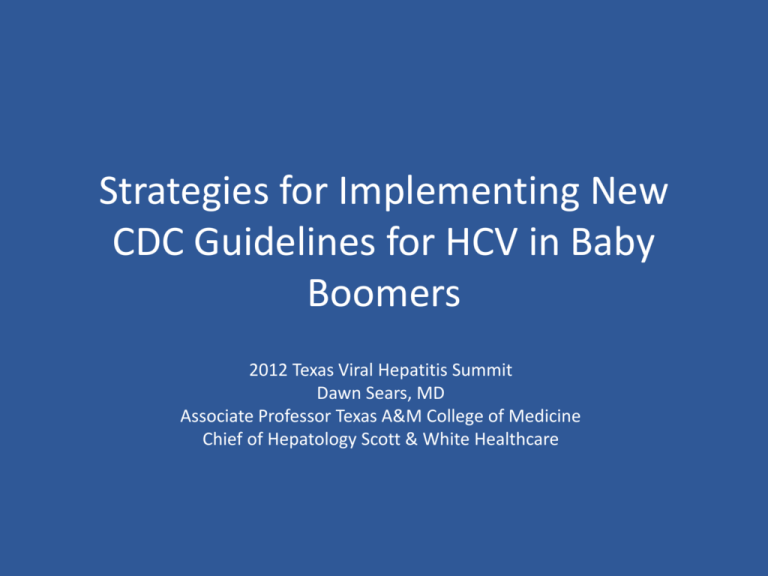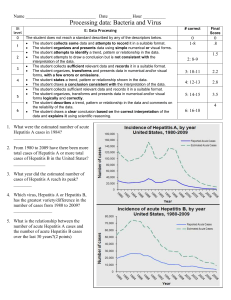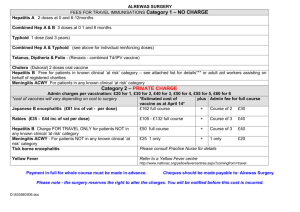Ethical Issues in Hepatitis C - Texas Department of State Health
advertisement

Strategies for Implementing New CDC Guidelines for HCV in Baby Boomers 2012 Texas Viral Hepatitis Summit Dawn Sears, MD Associate Professor Texas A&M College of Medicine Chief of Hepatology Scott & White Healthcare August 16, 2012 MMWR Hepatitis C • Most common reason for liver transplant in USA (40% of 5000 last year) • Over 4 million infected in USA • 1 out of 30 Babyboomers has it • 70% do not know they have it • 60-85% go on to have chronic liver disease – 5-20% develop cirrhosis within 20 years – 3% per year of these develop HCC – Treatment with interferon began in 1986 (virus identified in 1989) Reported Cases of Acute Hepatitis C by Selected Risk Factors, United States Percentage of Cases 80 Injecting drug use 70 60 50 40 30 20 Sexual 10 Health related work Transfusion 0 83-84 85-86 87-88 89-90 91-92 93-94 Year * 1983-1990 based on non-A, non-B hepatitis Source: CDC Sentinel Counties Study Source: CDC Sentinel Counties 95-96 97-98 Hepatitis C Virus High Risk Profile 100 90 80 70 60 50 40 30 20 10 0 85 ~80 10-20 4-6 Recipients of Injection Clotting Factors Drug Use Made Before 1987 5 4-7 Individuals Recipients Infants Born Long-Term to Infected Hemodialysis With Multiple of Blood Women Sex Partners Transfusions Prior to July 1992 Transmission Factor Alter et al. N Engl J Med. 1999;341:556-562. NIH Consensus Development Conference Statement. 2002. Ohto et al. N Engl J Med. 1994:330:744-750. Posttransfusion Hepatitis C % of Recipients Infected 30 All volunteer donors HBsAg 25 20 Donor Screening for HIV Risk Factors Anti-HIV ALT/Anti-HBc 15 10 Anti-HCV 5 0 1965 Improved HCV Tests 1970 1975 1980 1985 1990 Year Adapted from HJ Alter and Tobler and Busch, Clin Chem 1997 1995 2000 New Infections/100,000 Estimated Incidence of Acute HCV Infection United States, 1960-1999 140 120 100 80 60 40 20 0 1960 Decline in injection drug users Decline in transfusion recipients 1965 1970 1975 1980 1985 1989 1995 Year Source: Hepatology 2000;31:777-82; Hepatology 1997;26:62S-65S 1999 1 9 9 0 2000 The Prevalence of Hepatitis C Virus Infection in the United States. Gregory L. Armstrong, MD; Annemarie Wasley, ScD; Edgar P. Simard, MPH; Geraldine M. McQuillan, PhD; Wendi L. Kuhnert, PhD; and Miriam J. Alter, PhD Ann Intern Med. 16 May 2006;144(10):705-714 Hepatitis C: A Global Health Problem 170-200 Million (M) Carriers Worldwide United States 3- 4 M Americas 1212-15 M Western Europe 5M Eastern Europe 10 M Far East Asia 60 M Southeast Asia 3030-35 M Africa 3030-40 M Australia 0.2 M World Health Organization. Weekly epidemiological record. 1999;74:421-428. What did they REALLY mean?!! • All Babyboomers? • 1945-1965 birthyears – 3.25% prevalence – Accounts for 76.5% of all hepatitis C infections – Of HCV related deaths 73.4% occur in 45-64 year olds 1. One time screening – Regardless of risk factors 2. All persons HCV positive should receive brief alcohol screening and interventions and referral More Details Current Screening Recommendations • Hepatitis C: – All Baby boomers x 1 – Anyone with HIV – Anyone who ever injected illegal drug – Anyone who received: • Clotting factor prior to 1987 • Transfusion prior to 1992 • Transplant prior to 1992 – Dialysis – Abnormal ALT – Exposure • Hepatitis B: – Anyone born in country of prevalence of > 2% – Parents born in country of >8% prevalence (not India) – PWID – MSM – Need for immunosuppression – Blood Donors – All pregnant women – Abnormal ALT/AST – Exposure or household contact Screening • Screening at high risk venues….21% ultimately receive treatment • 80% of IV drug users from 1970’s and 80’s had hepatitis C • 20% of current IV drug users have hepatitis C 13 IOM • Institute of Medicine Report January 2010 • Hepatitis and Liver Cancer – A National Strategy for Prevention and Control of Hepatitis B and C – Hepatitis B and C are important public health problems – Patients and Doctors do not understand hepatitis B or C – Screening, Prevention and Access to care need to be improved • This should include integration into the current health care system 14 $$$ • Average annual cost after diagnosed with: • • • • Chronic hepatitis $8,000 Cirrhosis $10,000 Liver Cancer $18,000 Transplant $89,000 • Hepatitis Screen cost/charge • Hep C antibody $25/$136 • Hepatitis B surface Antigen $35/$99 • Hepatitis A Antibody $43/$118 • Hepatitis Vaccination • Hepatitis A Vaccination series $100 • Hepatitis B Vaccination series $60 15 Men • Men make up 70% of chronic hepatitis • Men do not go to the doctor • Women get screened for hepatitis B when pregnant • Women see doctors regularly • Men are more likely to get colonoscopy if their wife is also getting colonoscopy 16 Colonoscopy • 65%-70% of eligible central Texans have received an endoscopic examination of their colon • We have a very high rate of Colorectal Cancer Screenings with colonoscopy at Scott & White • This is often the ONLY physician encounter for men aged 50-60 17 Hypothesis Combining risk assessment and screening for viral hepatitis with colonoscopy will lead to better screening rates 18 How? • With preparation instructions patients were mailed 3 documents: – Introduction to the Study – What is Hepatitis? brochure – Testing and Vaccinating for Hepatitis brochure • Day of study: – Met with research nurse – Signed informed consent – Filled out patient risk form 19 How? Cont. • When IV was placed: – Blood was drawn for lab- hepatitis screening • 2-4 weeks later – Patients were called or written a letter with results and any possible follow-up instructions • 6 months – Fellows and research student searched EMR database to see if any of the newly diagnosed hepatitis followed up, and see how many completed needed vaccinations Results • 500 Baby boomers who appeared for colonoscopy were invited to participate • 376 (75.2%) Agreed – 42% Male, 58% Female • Risk Factors – – – – – – – – Number of Risk Factors 250 200 29- High risk Sexual 150 29- Tattoo prior to 2000 27- ”Other” risk factor 100 26- Inject or snort drug 24- Transfusion prior to 1992 50 20- Jail > 2 days 0 14- Health care worker stick 10 -Sexual partner with hepatitis 0 1 2 3 4 5 Results of Blood Tests • 77% did not have antibodies against both Hepatitis A and B Caucasian • No patients had Hepatitis B surface Antigen Hispanic • Three patients had Hepatitis C antibody African American Asian Follow up • Hepatitis C Antibody – 100% showed up in clinic/laboratory for follow up testing – 1 had follow up PCR positive – This patient is waiting for interferon free therapy, but has stopped drinking Conclusions • Hepatitis Screening in the population who undergo colonoscopy is highly accepted – 75% agreed – 3% Declined because they already knew they had hepatitis C – 10% Declined for fear of non-reimbursement • Hepatitis Screening had the highest yield for those patients who had risk factors – 100% of those found to have Hepatitis C Antibodies had risk factors Recommendations • Gastroenterologists see most baby boomers at least once – – – – – We should ask about risk factors We should consider screening for hepatitis B and C We understand the results We will often be the treating physician This provides the highest quality, most efficient healthcare for our patients 25 Leaves us with many current Questions…. • • • • What is best system to screen all babyboomers? Who should pay for screening? Who should pay for treatment? As treatments get more expensive, as babyboomers get more chronic health problemswill it still be cost-saving to cure? • Other questions still Loom: How many times do we re-transplant? Do we treat those who are still using or drinking? How long is long-enough sobriety? Do we re-treat non-compliant patients? Thank you for coming!! Questions? Current Recommendations for Chronic Hepatitis B in Health Care Workers • Updated CDC recommendations July 6, 2012 – Last recommendations 1991 • No longer state that patients be pre-notified of provider’s HBV status • HBV DNA use instead of e-antigen status • Thresh hold DNA <1,000 IU/ml • Standard precautions is preventing spread – Patient transmission of acute hepatitis B to provider » 1983: 10,000 cases » 2002: 400 cases » 2009: 100 cases Restricted Hep B procedures • Category I: • If likely to pose increased risk of percutaneous injury to health care provider – – – – – – – Major abdominal surgery Cardiothoracic surgery Orthopedic surgery Hysterectomy C-Section Vaginal delivery Major oral or maxillofacial surgery • Category II • All other procedures: – Surgical not in list I – Needles when hands are outside person’s body – Dental procedures – Insertion of tubes – Endoscopy/bronchoscopy – Internal exam with gloved hand and nothing sharp – External examinations What is recommendation? • Expert Review Panel at Institution – Evaluate providers’ status • Viral burden • Experience • Adherence to recommended techniques – Provide: • • • • • Recommendation Counseling Oversight Investigate breaches Confidentiality • Panel may include: – – – – – – – – – – – Co-Provider in specialty ID Epidemiology Hepatologist/Gastroenterologist Occupational health Student health PCP Ethicist HR Administrator Legal







